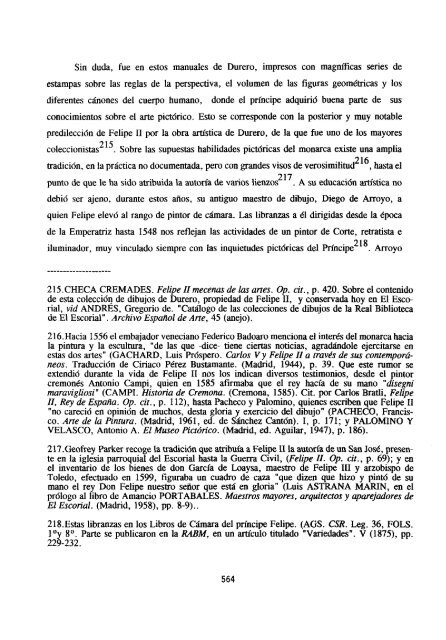ABRIR II PARTE. CAPÍTULO V. - Universidad Complutense de Madrid
ABRIR II PARTE. CAPÍTULO V. - Universidad Complutense de Madrid
ABRIR II PARTE. CAPÍTULO V. - Universidad Complutense de Madrid
You also want an ePaper? Increase the reach of your titles
YUMPU automatically turns print PDFs into web optimized ePapers that Google loves.
Sin duda, fue en estos manuales <strong>de</strong> Durero, impresos con magníficas series <strong>de</strong><br />
estampas sobre las reglas <strong>de</strong> la perspectiva, el volumen <strong>de</strong> las figuras geométricas y los<br />
diferentes cánones <strong>de</strong>l cuerpo humano, don<strong>de</strong> el príncipe adquirió buena parte <strong>de</strong> sus<br />
conocimientos sobre el arte pictórico. Esto se correspon<strong>de</strong> con la posterior y muy notable<br />
predilección <strong>de</strong> Felipe <strong>II</strong> por la obra artística <strong>de</strong> Durero, <strong>de</strong> la que fue uno <strong>de</strong> los mayores<br />
coleccionistas215. Sobre las supuestas habilida<strong>de</strong>s pictóricas <strong>de</strong>l monarca existe una amplia<br />
tradición, en la práctica no documentada, pero con gran<strong>de</strong>s visos <strong>de</strong> verosimilitud216 hasta el<br />
217<br />
punto <strong>de</strong> que le ha sido atribuida la autoría <strong>de</strong> varios lienzos . A su educación artística no<br />
<strong>de</strong>bió ser ajeno, durante estos años, su antiguo maestro <strong>de</strong> dibujo, Diego <strong>de</strong> Arroyo, a<br />
quien Felipe elevó al rango <strong>de</strong> pintor <strong>de</strong> cámara. Las libranzas a él dirigidas <strong>de</strong>s<strong>de</strong> la época<br />
<strong>de</strong> la Emperatriz hasta 1548 nos reflejan las activida<strong>de</strong>s <strong>de</strong> un pintor <strong>de</strong> Corte, retratista e<br />
iluminador, muy vinculado siempre con las inquietu<strong>de</strong>s pictóricas <strong>de</strong>l Príncipe218. Arroyo<br />
215.CHECA CREMADES. Felipe <strong>II</strong> mecenas <strong>de</strong> las artes. Op. cit., p. 420. Sobre el contenido<br />
<strong>de</strong> esta colección <strong>de</strong> dibujos <strong>de</strong> Durero, propiedad <strong>de</strong> Felipe <strong>II</strong>, y conservada hoy en El Escorial,<br />
vid ANDRES, Gregorio <strong>de</strong>. “Catálogo <strong>de</strong> las colecciones <strong>de</strong> dibujos <strong>de</strong> la Real Biblioteca<br />
<strong>de</strong> El Escorial”. Archivo Español <strong>de</strong> Arte, 45 (anejo).<br />
2 16.Hacia 1556 el embajador veneciano Fe<strong>de</strong>rico Badoaro menciona el interés <strong>de</strong>l monarca hacia<br />
la pintura y la escultura, “<strong>de</strong> las que -dice- tiene ciertas noticias, agradándole ejercitarse en<br />
estas dos artes” (GACHARD, Luis Próspero. Carlos Vy Felipe lía través <strong>de</strong> sus contemporáneos.<br />
Traducción <strong>de</strong> Ciriaco Pérez Bustamante. (<strong>Madrid</strong>, 1944), p. 39. Que este rumor se<br />
extendió durante la vida <strong>de</strong> Felipe <strong>II</strong> nos los indican diversos testimonios, <strong>de</strong>s<strong>de</strong> el pintor<br />
cremonés Antonio Campi, quien en 1585 afirmaba que el rey hacia <strong>de</strong> su mano “disegni<br />
maravigliosi” (CAMPI. Historia <strong>de</strong> Cremona. (Cremona, 1585). Cit. por Carlos Bratli, Felipe<br />
<strong>II</strong>, Rey <strong>de</strong> España. 0p. cit., p. 112), hasta Pacheco y Palomino, quienes escriben que Felipe <strong>II</strong><br />
“no careció en opinión <strong>de</strong> muchos, <strong>de</strong>sta gloria y exercicio <strong>de</strong>l dibujo” (PACHECO, Francisco.<br />
Arte <strong>de</strong> la Pintura. (<strong>Madrid</strong>, 1961, ed. <strong>de</strong> Sánchez Cantón). 1, p. 171; y PALOMINO Y<br />
VELASCO, Antonio A. El Museo Pictórico. (<strong>Madrid</strong>, ed. Aguilar, 1947), p. 186).<br />
217.Geofrey Parker recoge la tradición que atribuía a Felipe lila autoría <strong>de</strong> un San José, presente<br />
en la iglesia parroquial <strong>de</strong>l Escorial hasta la Guerra Civil, (Felipe IL Op. cit., p. 69); y en<br />
el inventario <strong>de</strong> los bienes <strong>de</strong> don García <strong>de</strong> Loaysa, maestro <strong>de</strong> Felipe <strong>II</strong>I y arzobispo <strong>de</strong><br />
Toledo, efectuado en 1599, figuraba un cuadro <strong>de</strong> caza “que dizen que hizo y pintó <strong>de</strong> su<br />
mano el rey Don Felipe nuestro señor que está en gloria” (Luis ASTRANA MARIN, en el<br />
prólogo al libro <strong>de</strong> Amancio PORTABALES. Maestros mayores, arquitectos y aparejadores <strong>de</strong><br />
El Escorial. (<strong>Madrid</strong>, 1958), pp. 8-9)..<br />
218.Estas libranzas en los Libros <strong>de</strong> Cámara <strong>de</strong>l príncipe Felipe. (AGS. CSR. Leg. 36, FOLS.<br />
1 0y 80. Parte se publicaron en la RABM, en un artículo titulado “Varieda<strong>de</strong>s”. y (1875), Pp.<br />
229-232.<br />
564

















